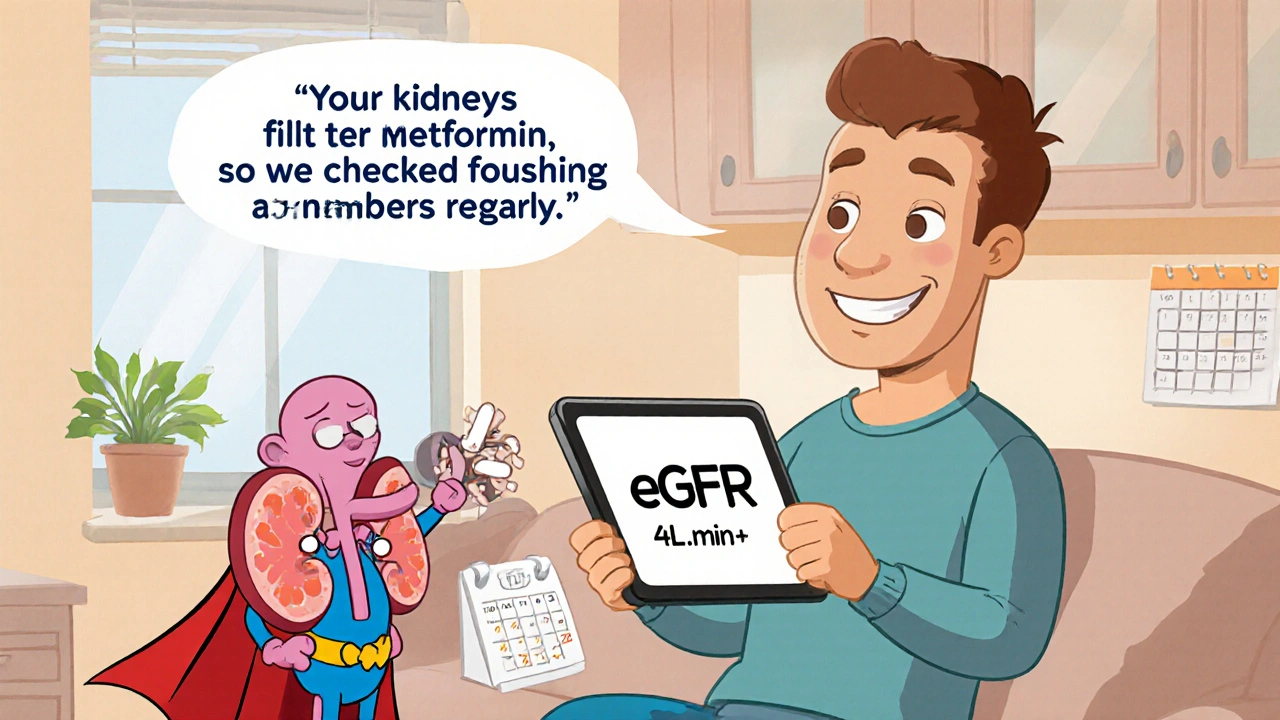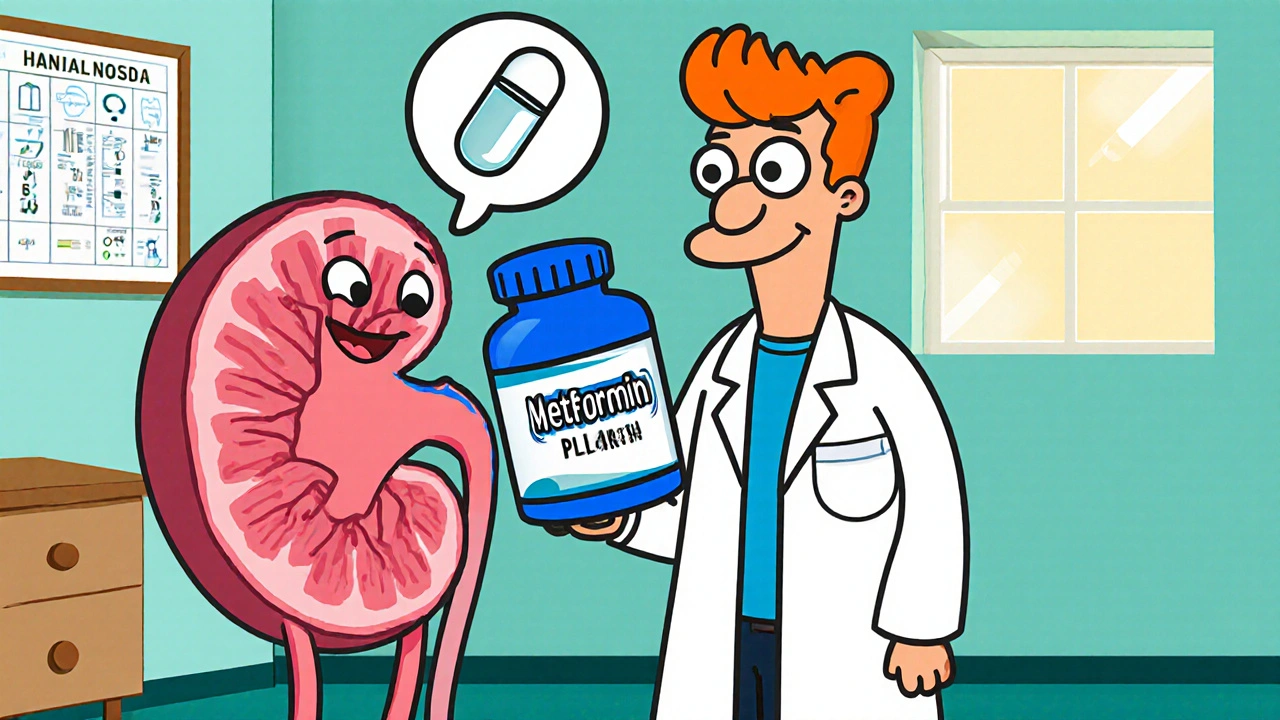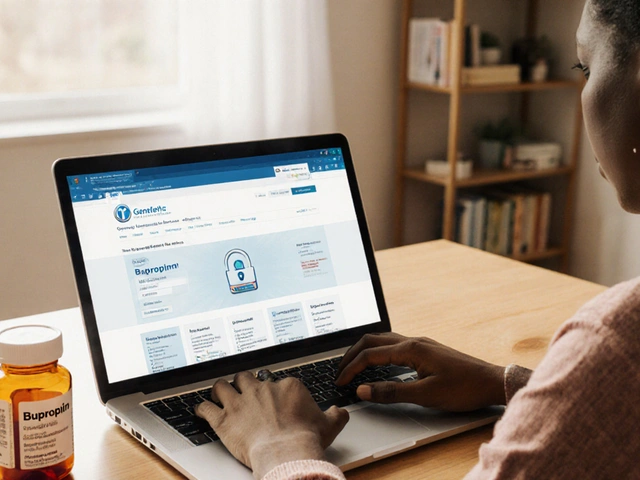Metformin Dosing Calculator
This calculator helps determine appropriate metformin dosing based on estimated glomerular filtration rate (eGFR), which measures kidney function. Metformin is excreted by the kidneys, so dosage must be adjusted as kidney function declines.
When treating type 2 diabetes, Metformin is a first‑line biguanide antihyperglycemic medication that lowers blood glucose by reducing hepatic glucose production and improving peripheral insulin sensitivity. Because it leaves the body exclusively through the kidneys, a drop in renal performance can turn a well‑tolerated drug into a safety risk. That’s why clinicians need a clear plan for metformin dosing when kidney function changes.
Why Kidney Function Matters for Metformin
Metformin is not metabolized by the liver; it is filtered and secreted unchanged by the nephrons. When the glomerular filtration rate (GFR) falls, the drug accumulates, raising the chance of lactic acidosis-a rare but potentially fatal condition. The myth that metformin itself damages the kidneys has been debunked by the FDA and major diabetes societies, yet the fear still leads to inappropriate discontinuation in up to 22 % of eligible patients (Cleveland Clinic chart review, 2022).
eGFR vs. Serum Creatinine: The Modern Metric
Until 2016, clinicians used serum creatinine cut‑offs (1.5 mg/dL for men, 1.4 mg/dL for women) to decide if metformin was safe. Evidence showed that creatinine alone was a blunt tool, especially in older adults with reduced muscle mass. The eGFR (estimated glomerular filtration rate) became the preferred metric because it adjusts for age, sex, and race, giving a more accurate picture of renal clearance.
Current Dosing Thresholds Based on eGFR
All major guidelines-FDA, ADA, NICE, AACE/ACE, KDIGO-agree on a hard stop at eGFR < 30 mL/min/1.73 m². Between 30 and 60 mL/min, the approach diverges. The table below captures the most widely accepted limits and monitoring intervals.
| eGFR (mL/min/1.73 m²) | Maximum Daily Dose | Monitoring Frequency | Notes |
|---|---|---|---|
| ≥ 60 | 2 550 mg | Every 6-12 months | Standard initiation |
| 45-59 | 2 000 mg | Every 3-6 months | Reduce dose; consider continuation only if benefit outweighs risk |
| 30-44 | 1 000 mg | Every 3 months | Close monitoring; avoid abrupt eGFR drops |
| 15-29 (stable) | 500 mg (selected patients) | Every 2 months | Only if patient is stable, no recent AKI, and benefit is clear |
| <30 | Contraindicated | - | Discontinue; consider alternative agents |
These numbers come from a synthesis of FDA labeling, the 2023 ADA Standards of Care, and Canadian RxFiles protocol, which offers the most granular guidance.
Monitoring Schedule: Keeping an Eye on Renal Trends
Renal function isn’t static. Acute kidney injury (AKI) from dehydration, NSAIDs, or contrast imaging can cause rapid eGFR drops. The National Kidney Foundation recommends:
- Baseline eGFR before starting metformin.
- Repeat eGFR every 12 months if ≥ 60 mL/min.
- Every 6 months for 45-59 mL/min.
- Every 3 months for 30-44 mL/min.
- Additional checks within 2 weeks after any event that could affect kidney function (e.g., new NSAID, infection, contrast study).
Documenting the trend helps differentiate a chronic decline from an acute dip, guiding whether to hold or adjust metformin.
Special Populations: Dialysis and Beyond
Patients on peritoneal dialysis can safely receive low‑dose metformin (≈ 250 mg/day), because the dialysate provides continuous clearance. For those on thrice‑weekly hemodialysis, a post‑dialysis dose of 500 mg each session is a common practice, but many clinicians prefer to stop metformin altogether due to the uncertainty of residual renal function.
Pregnant women with type 2 diabetes should be evaluated case‑by‑case. While metformin crosses the placenta, studies have not shown teratogenicity, and many obstetric guidelines allow continuation if eGFR is adequate.
Acute Situations: Contrast Imaging and AKI Risk
iodinated contrast agents can cause a temporary eGFR drop. Guidelines from the KDIGO advise holding metformin for 48 hours after contrast exposure if the baseline eGFR is < 60 mL/min, then rechecking renal function before restarting. In patients with eGFR ≥ 60, the risk is low, and many centers continue the drug while monitoring.
Practical Tips for Clinicians
- Start low, go slow. Begin at 500 mg once daily, increase by 500 mg weekly if tolerated.
- Document the exact eGFR value and the date of each measurement.
- Ask about over‑the‑counter NSAID use; advise alternatives like acetaminophen if eGFR < 60.
- Screen for vitamin B12 deficiency annually; metformin reduces absorption in 7-10 % of long‑term users.
- Educate patients: "Metformin doesn’t hurt your kidneys, but it needs kidneys to leave your body. That’s why we check your kidney numbers regularly."
These steps have reduced gastrointestinal‑related drop‑outs from 28 % to 9 % in a Cleveland Clinic quality‑improvement project (2022) and improved monitoring adherence by 35 % after targeted counseling.

Patient‑Facing Advice
Patients often wonder why a drug that controls sugar requires blood‑test appointments. A simple script works: "Your kidneys filter metformin out of your blood. If the filter slows down, the drug can build up. That’s why we check your kidney numbers every few months-just to keep you safe while you stay on a medicine that protects your heart."
Encourage patients to report any sudden weight loss, vomiting, or rapid breathing, as these can be early signs of lactic acidosis.
Emerging Guidelines and Future Directions
The 2023 KDIGO update adds individualized AKI risk assessment alongside eGFR, recommending a lower threshold for holding metformin in patients on multiple nephrotoxic drugs. Ongoing trials like MET‑FORMIN‑CKD (NCT04591127) are testing whether a 500 mg daily dose is safe in eGFR 25‑35 mL/min, with interim data expected mid‑2024.
Another promising development is the use of cystatin C‑based eGFR, which may be more accurate in the elderly and in those with abnormal muscle mass. The forthcoming 2024 ADA Standards of Care are expected to incorporate cystatin C as an alternative calculation method.
Bottom Line
Metformin remains the most cost‑effective first‑line therapy for type 2 diabetes, offering cardiovascular protection and glycemic control. The key to preserving those benefits while avoiding rare adverse events is a disciplined approach to renal monitoring and dose adjustment. By aligning with the eGFR‑based thresholds, scheduling regular labs, and communicating clearly with patients, clinicians can keep more people on metformin safely.
When should I stop metformin if my eGFR drops?
If eGFR falls below 30 mL/min/1.73 m², current FDA, ADA, and NICE guidance recommends stopping metformin. Between 30‑44, reduce the dose to 1 000 mg or less and monitor every 3 months.
Can metformin cause kidney disease?
No. Large studies and FDA reviews show metformin does not damage kidneys. The drug simply needs functional kidneys to clear it, which is why we check eGFR.
How often should eGFR be checked in a patient on metformin with CKD stage 3?
Guidelines suggest every 3 months for eGFR 30‑44 mL/min/1.73 m² (CKD stage 3b) and every 6 months for eGFR 45‑59 mL/min/1.73 m² (stage 3a).
Is it safe to give metformin after a contrast CT scan?
If baseline eGFR is ≥ 60, most centers continue metformin and re‑check renal function after 48 hours. If eGFR is < 60, hold the drug for 48 hours post‑contrast, then reassess before restarting.
What should I do if a patient on metformin develops lactic acidosis?
Treat as a medical emergency: stop metformin, give IV bicarbonate, and provide renal replacement therapy if needed. Prompt recognition is critical because true metformin‑associated lactic acidosis is rare but severe.






Amanda Vallery
October 24, 2025 AT 15:51Metformin's clearance drops sharply once eGFR falls below 30, so dose reduction is mandatary. Watch for lactic acidosis signs.
Marilyn Pientka
November 5, 2025 AT 17:15One must recognize that the pharmacokinetic profile of metformin is inexorably linked to renal clearance, rendering any disregard for eGFR thresholds a flagrant violation of clinical prudence. The contemporary consensus mandates dose tapering at eGFR 45‑60 mL/min/1.73 m², yet many persist in invoking antiquated creatinine cut‑offs, betraying a lamentable adherence to obsolescent dogma. Such obstinacy not only undermines therapeutic efficacy but also jeopardizes patient safety through potential lactic acidosis. It is incumbent upon practitioners to internalize guideline‑driven dosing algorithms, thereby harmonizing practice with evidence‑based standards. Failure to do so reflects a dereliction of fiduciary duty to the patient.
Jordan Levine
November 17, 2025 AT 19:39Look, if you think you can just ignore the eGFR charts, you’re living in a fantasy world 😤. The kidneys are the only exit route for metformin, and when they’re compromised the drug piles up like a traffic jam on the highway 🏥. Don't be a hero, be smart and dose down. 🚨
Carla Taylor
November 29, 2025 AT 22:03Totally agree this is super important keep an eye on those numbers and adjust slowly stay positive
Kathryn Rude
December 12, 2025 AT 00:27When one contemplates the metaphysical ramifications of dose modulation one must ask: does the kidney whisper its will or do we impose our will upon it? It is a dance of balance and, in my humble opinion, we often step on each other's toes :)
Lindy Hadebe
December 24, 2025 AT 02:51Fine, just follow the tables.